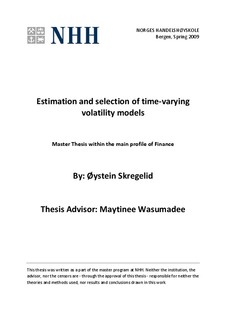| dc.description.abstract | This paper describes methods that can be applied to select the best conditional volatility
model for an individual asset. Three exchange traded funds (ETFs) for the financials, energy
and utilities sectors of the Dow Jones Total Market Index are evaluated to illustrate the
complexity of model selection. For the univariate series, the symmetric GARCH model and
three asymmetric models (EGARCH, GJR-GARCH and TGARCH) with a variety of lag structures
are parameterized under the assumption of both normal and t-distributed errors. The
ranking of these models are based on how well the parameters of each model fit to the
underlying data set (the likelihood), on selection criterions (AIC and BIC) and on their
forecasting ability (through statistic and economic loss functions). The results show that
different volatility models with different lag structures are selected for each of the three
sectors. For the financial sector a t-distributed EGARCH(1,2,1) model gives the most
satisfying results. The energy sector is best described by a t-distributed GJR-GARCH(1,1,2)
model, while a normal distributed GJR-GARCH(1,1,1) model is recommended for the utilities
sector.
In addition to the selection of univariate models, multivariate models are described and
tested. The main focus in this part is on the Dynamic Conditional Correlation model that
builds on univariate parameterizations of the volatility. A DCC model based on three
univariate normal distributed GJR-GARCH(1,1,1) models is compared to the BEKK model and
to a multivariate EWMA model. This comparison shows that while the DCC model performs
best when it comes to minimizing the risk of a portfolio, the BEKK model is superior when
evaluated on the reward-to-variability ratio (Sharpe). This is mainly due to the fact that the
DCC model is unable to catch the time-varying correlation between the three chosen assets. | en |
